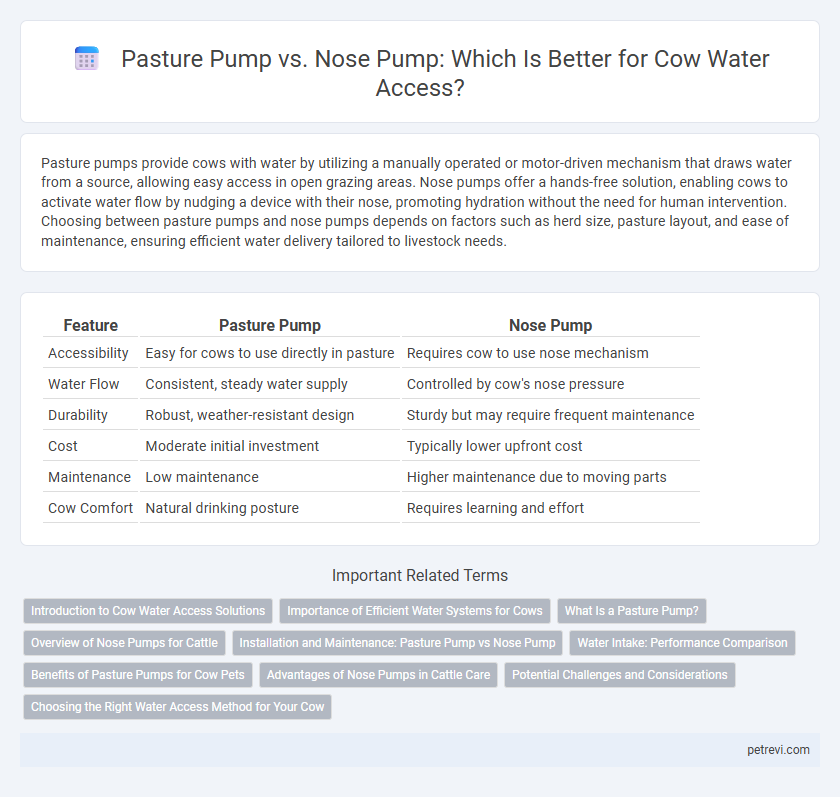Pasture pumps provide cows with water by utilizing a manually operated or motor-driven mechanism that draws water from a source, allowing easy access in open grazing areas. Nose pumps offer a hands-free solution, enabling cows to activate water flow by nudging a device with their nose, promoting hydration without the need for human intervention. Choosing between pasture pumps and nose pumps depends on factors such as herd size, pasture layout, and ease of maintenance, ensuring efficient water delivery tailored to livestock needs.
Table of Comparison
| Feature | Pasture Pump | Nose Pump |
|---|---|---|
| Accessibility | Easy for cows to use directly in pasture | Requires cow to use nose mechanism |
| Water Flow | Consistent, steady water supply | Controlled by cow's nose pressure |
| Durability | Robust, weather-resistant design | Sturdy but may require frequent maintenance |
| Cost | Moderate initial investment | Typically lower upfront cost |
| Maintenance | Low maintenance | Higher maintenance due to moving parts |
| Cow Comfort | Natural drinking posture | Requires learning and effort |
Introduction to Cow Water Access Solutions
Pasture pumps provide cows with a reliable water source directly in grazing areas, minimizing the need for the animals to leave the pasture for hydration. Nose pumps, attached to the water tanks, encourage cows to activate water flow by nudging them with their noses, ensuring fresh and clean water access. Both systems improve water delivery efficiency and animal health by promoting consistent hydration in pasture environments.
Importance of Efficient Water Systems for Cows
Efficient water systems such as pasture pumps and nose pumps are crucial for maintaining optimal hydration and health in cows, directly impacting milk production and overall herd performance. Pasture pumps provide a reliable water source in grazing areas, reducing the need for frequent human intervention and minimizing stress on the animals. Nose pumps encourage natural drinking behavior and can prevent water contamination, promoting better water quality and hygiene essential for cow welfare.
What Is a Pasture Pump?
A pasture pump is a manual or automatic water pump designed to provide cows with easy access to clean water directly in the pasture, reducing their need to return to a central water source. This type of pump typically operates by converting mechanical energy from the cow's movement, such as stepping on a treadle or pushing a lever, into water flow, enhancing water availability in remote grazing areas. Pasture pumps improve hydration efficiency and encourage cows to drink more frequently, promoting better health and productivity.
Overview of Nose Pumps for Cattle
Nose pumps for cattle provide an efficient and hygienic solution for water access by utilizing a mechanical system activated through the cow's natural behavior of nudging or pressing with its nose. These pumps minimize water wastage and reduce contamination risks compared to traditional pasture pumps, ensuring cleaner drinking water for livestock. Their durable design suits various farm environments, improving cattle welfare by allowing easier and more consistent hydration.
Installation and Maintenance: Pasture Pump vs Nose Pump
Pasture pumps require manual installation involving mounting near water sources and securing stable footing, while nose pumps are directly attached to the cow's nose ring, allowing more mobility but demanding precise fitting to avoid discomfort. Maintenance for pasture pumps includes regular lubrication, inspecting seals, and clearing debris to ensure steady water flow, whereas nose pumps necessitate frequent cleaning and checking for wear on the nozzle and attachment points to prevent irritation or infections. Both systems have tailored upkeep protocols, but pasture pumps typically offer easier access for repairs compared to the more delicate, animal-associated maintenance of nose pumps.
Water Intake: Performance Comparison
Pasture pumps provide cows with a consistent and natural water flow, encouraging higher water intake by simulating a natural drinking environment, whereas nose pumps require active manipulation by cows which can limit water access and reduce overall consumption. Studies indicate that cows using pasture pumps increase their daily water intake due to easier and more intuitive access, promoting better hydration and milk production. Optimizing water delivery through pasture pumps enhances animal welfare and supports efficient farm water management compared to the more labor-intensive nose pump systems.
Benefits of Pasture Pumps for Cow Pets
Pasture pumps provide cows with consistent access to fresh water directly in grazing areas, promoting natural drinking habits and reducing stress. These pumps are designed for durability and ease of use, ensuring efficient water delivery with minimal maintenance. Their placement encourages cows to stay hydrated while foraging, improving overall health and milk production.
Advantages of Nose Pumps in Cattle Care
Nose pumps provide cows with easy and hygienic access to water by encouraging natural licking behavior, reducing contamination compared to pasture pumps. These pumps require less maintenance and prevent water stagnation, promoting better health and hydration in cattle. Their ergonomic design supports efficient water delivery, minimizing wastage and ensuring consistent availability.
Potential Challenges and Considerations
Pasture pumps for cow water access can face challenges such as limited water flow and the need for regular maintenance to prevent clogging from debris. Nose pumps, while reducing water contamination risk, may require cows to adapt to the facial interface, which could delay water intake and impact hydration. Both systems demand careful site placement and routine checks to ensure consistent and clean water supply, critical for maintaining cow health and productivity.
Choosing the Right Water Access Method for Your Cow
Pasture pumps provide a durable, low-maintenance water source that automatically refills as cows drink, ideal for large grazing areas requiring constant access to fresh water. Nose pumps demand active participation from cows, as they must manipulate the pump themselves to draw water, which can encourage natural behaviors but may not suit all animals or farm setups. Selecting the right water access method depends on herd size, behavior, pasture layout, and maintenance capacity to ensure cows remain hydrated efficiently and healthily.
Pasture Pump vs Nose Pump for Cow Water Access Infographic

 petrevi.com
petrevi.com